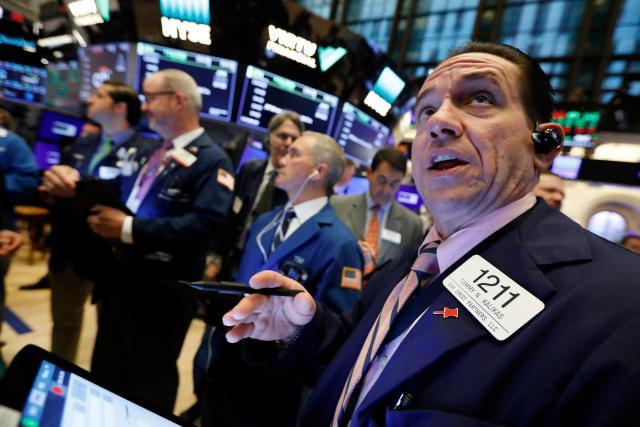Trump's First Term: A Deep Dive into Market Performance
Meta Description: Analyzing the market's response to Trump's presidency, exploring the performance of the US dollar, stocks (including Nasdaq), gold, oil, and major Asian markets like the Hang Seng Tech Index and A-shares, during his first term. Discover key insights and trends.
Trump's return to the White House is on the horizon, sparking intense market speculation. His first term left an undeniable mark on global finance, a period characterized by both dramatic surges and unexpected plateaus. This isn't just a dry recitation of numbers; it's a detailed exploration of the economic rollercoaster that defined the Trump era. We'll unravel the intricate tapestry of market movements – from the seemingly contradictory performance of the dollar to the skyrocketing gains in tech stocks and the surprising resilience of gold. Buckle up, because this isn't your average financial recap. We're diving deep, using real data and insightful analysis to paint a comprehensive picture, offering a unique perspective that goes beyond the surface-level headlines. This isn't about regurgitating facts; it's about understanding the why behind the numbers, connecting the dots between policy decisions, market sentiment, and the resulting financial fallout. Prepare to gain a sharper, more nuanced understanding of the market dynamics that shaped the Trump presidency's economic landscape. You'll uncover trends that might surprise you, learn how to interpret economic indicators, and gain insights applicable to your own financial strategies. Are you ready to navigate this compelling journey through the financial history of the Trump era? Let's begin.
The US Dollar: A Weaker Greenback?
The first four years of the Trump administration witnessed a relatively weak US dollar. While individual months saw fluctuations, the overall trend revealed a downward trajectory. The initial three months alone showed a 1.31% decline in the US Dollar Index (USDX). By the end of his first term, the cumulative loss reached a significant 10.53%. This weakening dollar, often attributed to Trump's fiscal policies and trade disputes, had significant ripple effects across global markets. It made US exports more competitive but also fueled inflation concerns in the US.

This chart clearly illustrates the dollar's weakening trend throughout Trump's first term. However, interpreting this data requires context. Factors beyond the President's policies, such as global economic shifts and monetary policy decisions by the Federal Reserve, also played a crucial role. It's crucial to avoid oversimplification; the dollar’s performance was a complex interplay of various economic forces.
US Stock Market Boom: A Bullish Run
In stark contrast to the dollar's performance, the US stock market experienced a period of remarkable growth during Trump's first term. The S&P 500, a broad market index, soared by over 67%. But the real star of the show was the Nasdaq Composite, an index heavily weighted towards technology stocks, which experienced an astonishing 138% surge! This phenomenal growth was driven by a combination of factors, including corporate tax cuts, deregulation efforts, and investor optimism surrounding the administration's economic agenda.


This dramatic growth, however, wasn't without its critics. Some argued that the gains were unsustainable, driven by artificially low interest rates and fueled by massive government spending. Others pointed to the concentration of growth in the tech sector, creating concerns about market imbalances. This period highlights the complex relationship between political leadership, economic policy, and market performance.
Asian Markets: A Mixed Bag
While US markets boomed, Asian markets presented a more nuanced picture. The Hang Seng Tech Index, a benchmark for technology companies in Hong Kong, experienced a remarkable 147% surge, even outpacing the Nasdaq. This growth reflected the increasing influence of Chinese tech giants and the broader shift towards a more technology-driven global economy. However, the performance of mainland Chinese A-shares was more modest. The Shenzhen Component Index (a broader index) saw a roughly 53% increase, while the Shanghai Composite Index, a more conservative indicator, registered a more modest 15% gain. This disparity highlights the varying levels of exposure and sensitivity to global economic trends across different Asian markets.





The contrasting performance of these markets illustrates the complexities of global finance and the interconnectedness of economies. Geopolitical factors, trade relationships, and domestic policy differences all played significant roles in shaping these outcomes.
Commodities: Gold Shines, Oil Remains Steady
The commodity markets during Trump's first term showcased a divergence in performance. Gold, often seen as a safe haven asset, experienced a remarkable 52% increase. This surge can be attributed to several factors, including uncertainty surrounding the administration's policies, global geopolitical tensions, and the overall weakening of the dollar. Conversely, crude oil prices remained relatively flat throughout the period, reflecting a complex interplay of supply and demand factors, OPEC policies, and global economic growth.


The contrasting behaviors of gold and oil underscore the sector-specific nature of market responses to political and economic events. While some assets thrive in uncertain times, others remain comparatively unaffected.
Frequently Asked Questions (FAQs)
Q1: Was the stock market's performance solely due to Trump's policies?
A1: No, while Trump's policies played a significant role (tax cuts, deregulation), other factors contributed significantly, including global economic conditions, technological advancements, and monetary policies implemented by the Federal Reserve. It's crucial to avoid assigning causality solely to one factor.
Q2: Why did the dollar weaken under Trump's presidency?
A2: The weakening dollar resulted from a combination of factors, including the administration's fiscal policies (increased government spending and deficits), trade disputes that impacted the US trade balance, and shifts in global economic sentiment.
Q3: What is the significance of the Hang Seng Tech Index's performance?
A3: The Hang Seng Tech Index's strong performance reflects the increasing global influence of Chinese technology companies and the broader shift towards technology-driven economic growth.
Q4: How did the performance of gold reflect the overall economic climate?
A4: The rise in gold prices indicated increased investor uncertainty and a flight to safety, driven by concerns over global economic and political stability.
Q5: Did Trump's policies directly cause the fluctuations in oil prices?
A5: While Trump's policies indirectly impacted oil prices (e.g., through trade disputes and sanctions), the main drivers of oil price fluctuations remained traditional supply and demand dynamics, OPEC actions, and geopolitical events.
Q6: Can we expect similar market trends during Trump's second term?
A6: Predicting future market trends is inherently challenging. While past performance can offer some guidance, numerous factors can influence future outcomes, making it impossible to definitively predict similar trends. The global economic landscape, geopolitical events, and the specifics of Trump's future policies will all play crucial roles.
Conclusion
Trump's first term presented a fascinating case study in the complex interplay between political leadership, economic policies, and market dynamics. While some sectors experienced remarkable growth, others showed more modest or even declining performance. It's crucial to remember the interconnectedness of global markets and the multitude of factors that shape asset prices. This complex interplay demands careful analysis, avoiding oversimplification and recognizing the limits of assigning causality to any single factor. The lessons learned from this period should inform future analyses and investment strategies, emphasizing the importance of a nuanced and holistic approach to understanding market behavior.



